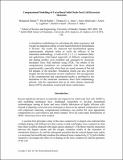Files in this item
Computational modelling of ceria-based solid oxide fuel cell electrolyte materials
Item metadata
| dc.contributor.author | Ahmed, Mohamed | |
| dc.contributor.author | Rodley, David | |
| dc.contributor.author | Jones, Thomas D.A. | |
| dc.contributor.author | Abdolvand, Amin | |
| dc.contributor.author | Lightfoot, Alison E. | |
| dc.contributor.author | Früchtl, Herbert | |
| dc.contributor.author | Baker, Richard T. | |
| dc.date.accessioned | 2022-03-24T16:30:02Z | |
| dc.date.available | 2022-03-24T16:30:02Z | |
| dc.date.issued | 2021-07-18 | |
| dc.identifier | 275515439 | |
| dc.identifier | a0a3c973-c225-420c-af96-ea3abbcd8b0e | |
| dc.identifier | 85111639363 | |
| dc.identifier.citation | Ahmed , M , Rodley , D , Jones , T D A , Abdolvand , A , Lightfoot , A E , Früchtl , H & Baker , R T 2021 , Computational modelling of ceria-based solid oxide fuel cell electrolyte materials . in 17th International Symposium on Solid Oxide Fuel Cells, SOFC 2021 . ECS Transactions , no. 1 , vol. 103 , IOP Publishing Ltd. , pp. 931-947 , 17th International Symposium on Solid Oxide Fuel Cells , 18/07/21 . https://doi.org/10.1149/10301.0931ecst | en |
| dc.identifier.citation | conference | en |
| dc.identifier.isbn | 9781607685395 | |
| dc.identifier.issn | 1938-6737 | |
| dc.identifier.other | ORCID: /0000-0001-6647-4266/work/98785470 | |
| dc.identifier.other | ORCID: /0000-0002-3304-3280/work/98785556 | |
| dc.identifier.uri | https://hdl.handle.net/10023/25098 | |
| dc.description.abstract | A simulation methodology for calculating the lattice parameter and oxygen ion migration energy of ceria-based electrolyte formulations is devised. The results are analysed and benchmarked against experimentally obtained values to verify the efficacy of the simulation methodology. A total of 26, 2 x 2 x 2 samarium (Sm)- and gadolinium (Gd)-doped supercells of different compositions and doping profiles were modelled and simulated by molecular mechanics force field methods using CP2K. The results of the computational simulations are comparable with those obtained experimentally, especially when there are equal amounts of Sm and Gd dopants in the structure. Simulation results can also provide insights into the mechanisms of ionic conduction. The incongruence of the computational and experimental results is attributed to the limitations of the molecular mechanics force field methodology utilised, with the expectation that an ab initio density functional theory (DFT) calculation would yield closer conformance. | |
| dc.format.extent | 17 | |
| dc.format.extent | 1388892 | |
| dc.language.iso | eng | |
| dc.publisher | IOP Publishing Ltd. | |
| dc.relation.ispartof | 17th International Symposium on Solid Oxide Fuel Cells, SOFC 2021 | en |
| dc.relation.ispartofseries | ECS Transactions | en |
| dc.subject | QD Chemistry | en |
| dc.subject | Engineering(all) | en |
| dc.subject | 3rd-DAS | en |
| dc.subject | AC | en |
| dc.subject.lcc | QD | en |
| dc.title | Computational modelling of ceria-based solid oxide fuel cell electrolyte materials | en |
| dc.type | Conference item | en |
| dc.contributor.institution | University of St Andrews. School of Chemistry | en |
| dc.contributor.institution | University of St Andrews. Centre for Energy Ethics | en |
| dc.contributor.institution | University of St Andrews. EaSTCHEM | en |
| dc.contributor.institution | University of St Andrews. St Andrews Sustainability Institute | en |
| dc.identifier.doi | 10.1149/10301.0931ecst | |
| dc.identifier.url | https://discovery.dundee.ac.uk/en/publications/computational-modelling-of-ceria-based-solid-oxide-fuel-cell-elec | en |
This item appears in the following Collection(s)
Items in the St Andrews Research Repository are protected by copyright, with all rights reserved, unless otherwise indicated.

